The CUBOT H1 Smartphone Test: A Month with 3-4 Days of Battery per Charge
by Ian Cutress on December 23, 2015 9:01 AM EST- Posted in
- Smartphones
- Mobile
- Battery
- CUBOT
Benchmarks
It seems somewhat silly to run performance benchmarks when most media outlets talk about high performance smartphones most of the time, but my point to consider is my old phone, and whether moving from quad core Krait 300 at 1.7GHz to a MediaTek quad core A53 chipset at 1.0 GHz but running a newer Android is better or worse. For some of the regular smartphone tests I don’t actually own the prerequisite hardware of our smartphone team, but here are some tests I was able to run, and the devices I had to hand at the time:
| Devices on Hand for Testing | |
| Cubot H1 | MediaTek 6735P |
| HTC Desire 610 | Snapdragon 400 |
| HTC One Max | Snapdragon 600 |
| Huawei Mate S | Kirin 935 |
| Huawei Nexus 6P | Snapdragon 810 |
| Google Nexus 7 2013 | Snapdragon S4Pro |
| Amazon Fire HD 6 (Limited) | MediaTek MT8135 |
| OnePlus X | Snapdragon 801 |

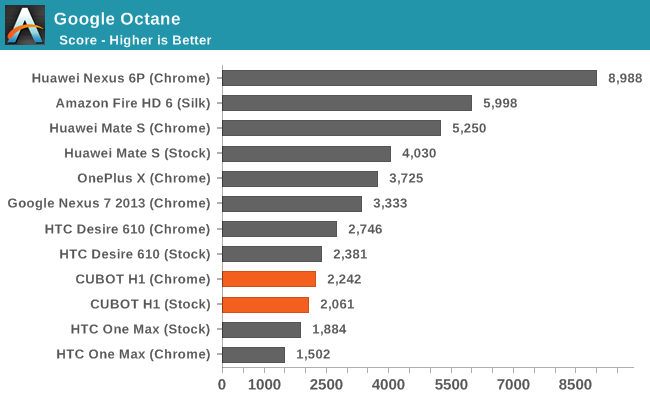
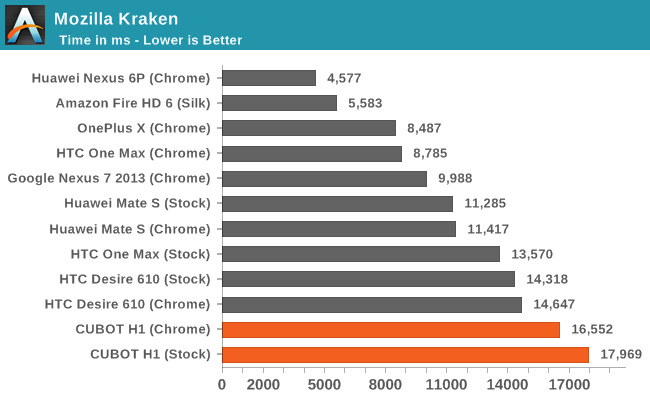
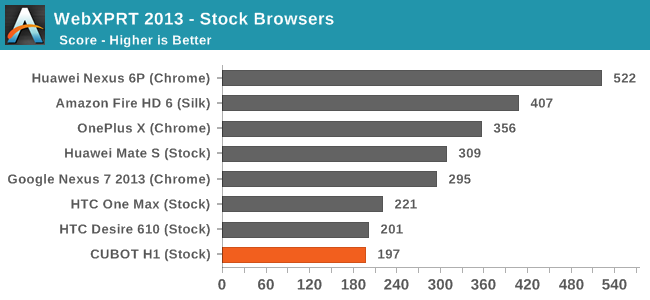
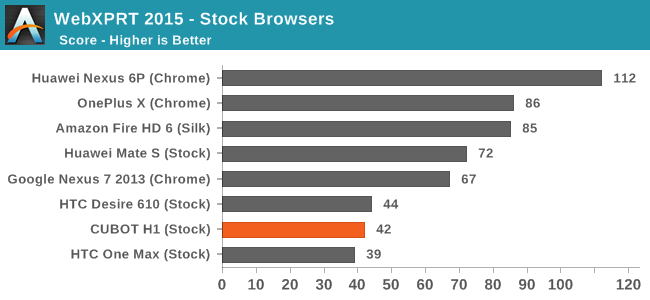
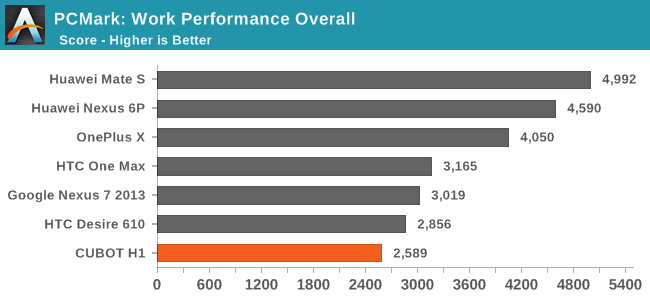
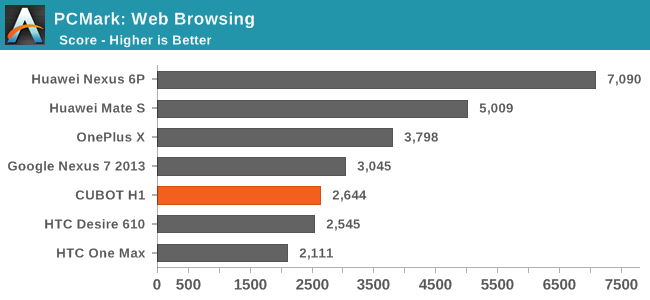

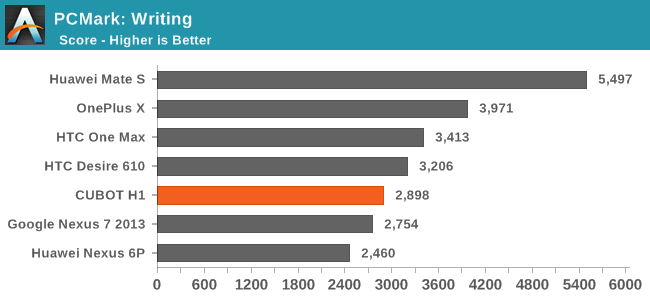
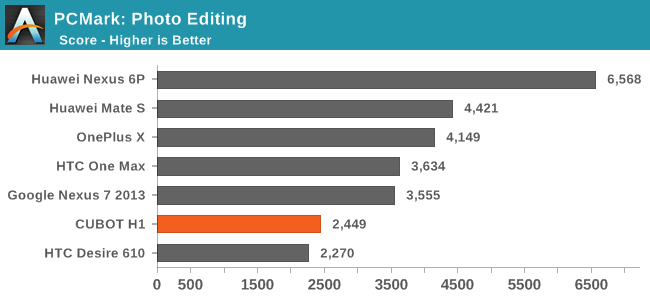
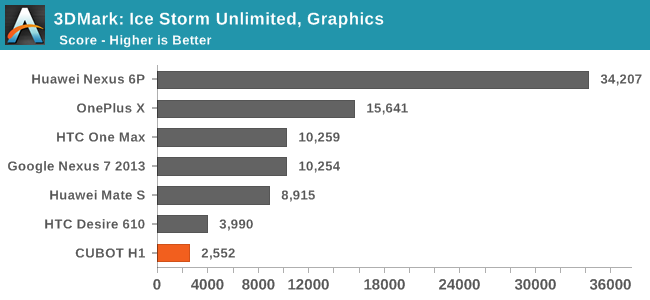
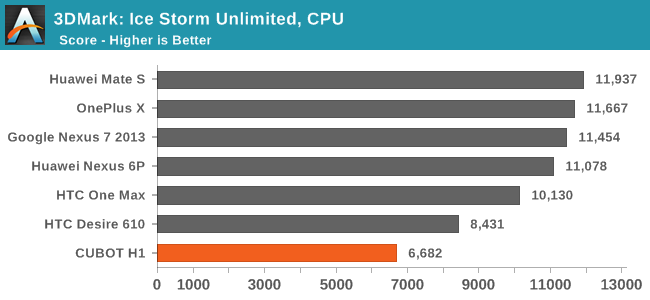

When we talk about Qualcomm’s Snapdragon 400 family or Intel's partnership with Rockchip partnership for Sofia and Atom, it makes me somewhat sad we don't have many new data points to compare to the MediaTek MT6735P inside the Cubot H1. However the one benchmark were all interested in is the battery life:
So let's put it this way - the H1 on a full charge breaks the Geekbench3 test to the point that it thinks you are cheating. Oops.
With the PCMark test it gets over 15hrs compared to the 6hrs of the Galaxy S6. When you have a large battery and not many pixels to push, with the right efficiency the device will last a night out with only 25% left in the tank in the way that high end smartphones do not. Anecdotally, as I'm writing this, I just spent a few hours in meetings across the other side of London - I spent 30 minutes each way on the tube with Evernote open and being used (albeit with no wireless or updates), and the battery went down from 38% to 33%. That's an hour of solid writing with black text on white for at most 5% of battery.


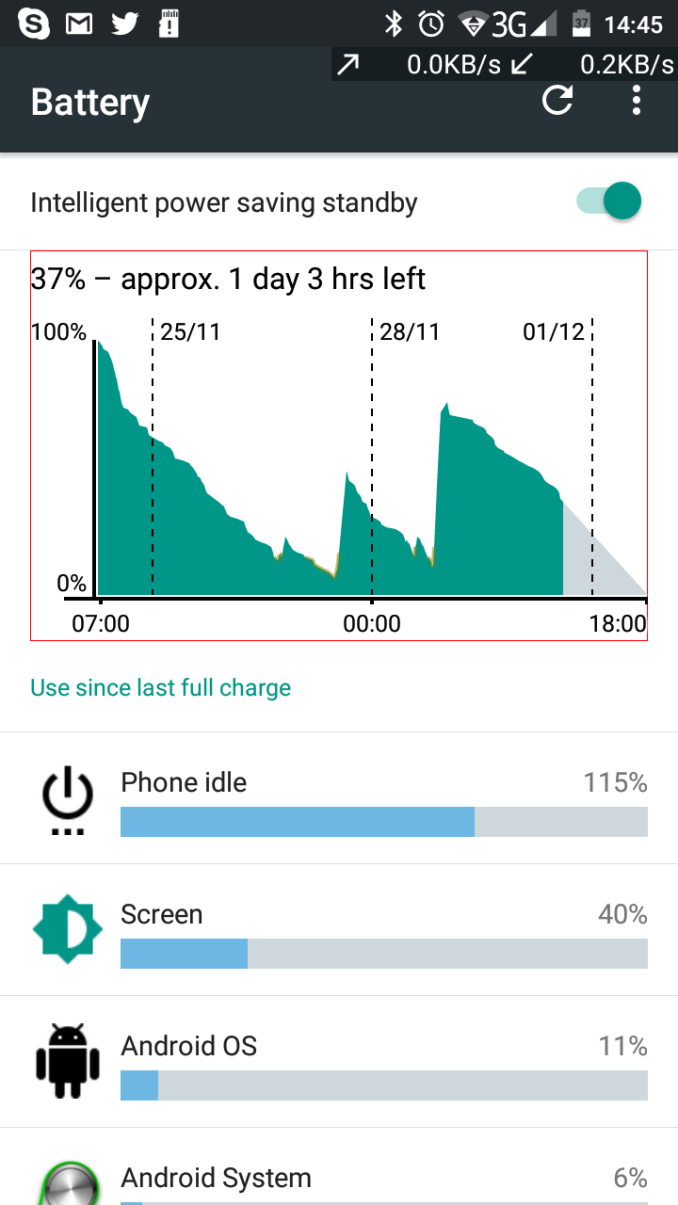
Initial use, first battery run down and more aggressive use
When I first started using the H1, the graph on the left was my battery usage estimation. Saying ‘approximiately 4 days left’ is almost unheard of, but with a regular 10% screen on time, the result was the graph in the middle, successfully predicting four days of battery. On the right is another example of my use, although a little bit more aggressive with some charging. Yes, I can confirm that there seems to be something wrong with those percentage calculations. But a quick charge in airplane mode for a few minutes gives a few percentage points of battery – while a lot of smartphones offer quick charging for the capacity to fill quickly, it still depends on the capacity drain of the SoC. It helps to have the best of both worlds. Of course, the downside of this is that it can take 3hrs and up to fully charge the H1. The H1 does come with a cable so you can charge other devices though, as 5200 mAh matches some battery packs.











116 Comments
View All Comments
shabby - Wednesday, December 23, 2015 - link
Perhaps we should stop calling these phones since only one sentence is used to describe its calling ability.Mushkins - Wednesday, December 23, 2015 - link
To be fair, what else do you need in a review of a voice call? Either it sounds like you're talking through a tube full of muddy squirrels or it sounds like a cell phone quality voice call (aka tolerable but not great). Getting into technical metrics of sound quality for a voice call is overkill for a consumer-focused review of a smartphone.aggiechase37 - Wednesday, December 23, 2015 - link
See I have to disagree here. If I want drive by, non specific reviews I would go to something like PCmag, where everything is, "seemed fine to me." Drivel. I come to Anandtech because I want in depth reviews. I do wish the call quality portion of the review was more in depth. I use my phone for a lot of business as well, and having the other person perceive my call quality as being crapola is a very important consideration for me. Dear Anandtech, please spend more time on call quality in your reviews. Please!?!?raja_jagadeesan - Wednesday, December 23, 2015 - link
I might agree with aggiechase. I actually find anandtech's cell phone reviews pretty outstanding. But adding more technical metrics or objective measures of call quality would really add value, I think. Partly because it is so hard to find elsewhere. My wife complains about her call quality and I sometimes wonder how to differentiate whether we need a new service or a new phone or if it is the Wi-Fi calling that is at issue, etc. More technical analysis of actual call quality and calling experience would be very useful.Ian Cutress - Wednesday, December 23, 2015 - link
Hi aggiechase37,I'm not the typical smartphone reviewer, as you might imagine from this review. It was originally going to be a hands on piece, like my previous One max piece (link below), but 750 words quickly became 3000 as I explored more aspects of the phone. It wasn't intended to be a full blown expose such as what we normally do, especially given the scale of the device, partly because I don't have the tools but also it's more an experiential test than anything else.
-Ian
My previous One max road test: http://www.anandtech.com/show/7551/a-month-with-th...
jjj - Wednesday, December 23, 2015 - link
The most important metric would be signal strength and nobody can be bothered to test that since blaming the carrier for dropped calls instead of the phone maker is easier.. The most reliable public info is this (in danish) http://www.dr.dk/nyheder/penge/kontant/saa-daarlig... or in English try this http://www.gsmarena.com/apple_iphone_6s_reception_...saratoga4 - Wednesday, December 23, 2015 - link
That would be an extraordinarily difficult test to perform accurately and in a way that was fair to devices with different types of radios. Even simple antenna testing (disconnected from a radio) is complex, testing an antenna, a radio, and firmware is probably beyond the means review sites.jjj - Wednesday, December 23, 2015 - link
Yes and no, you can try to do your best and achieve reasonable results with limited resources.A little data is a lot better than no data at all.
jjj - Wednesday, December 23, 2015 - link
Nowadays it helps that you can buy very cheap Chinese tools from places like Aliexpress. Sure a 100$ tool is not as good as a 5k$ tool but can be decent in many cases.Notmyusualid - Sunday, December 27, 2015 - link
It would still be very useful information!Keep it simple, test each phone in a number of fixed locations, at a specific time of day for each handset (to keep the network load 'fixed'), and run your call / data tests.
Repeat all the above on a 2.5hr+ train journey (similar to how the Japanese test theirs) to monitor call hand-off etc too...
A pattern will nevertheless emerge of who makes the most sensitive receivers, and as you allude to - how the total package ends up working.